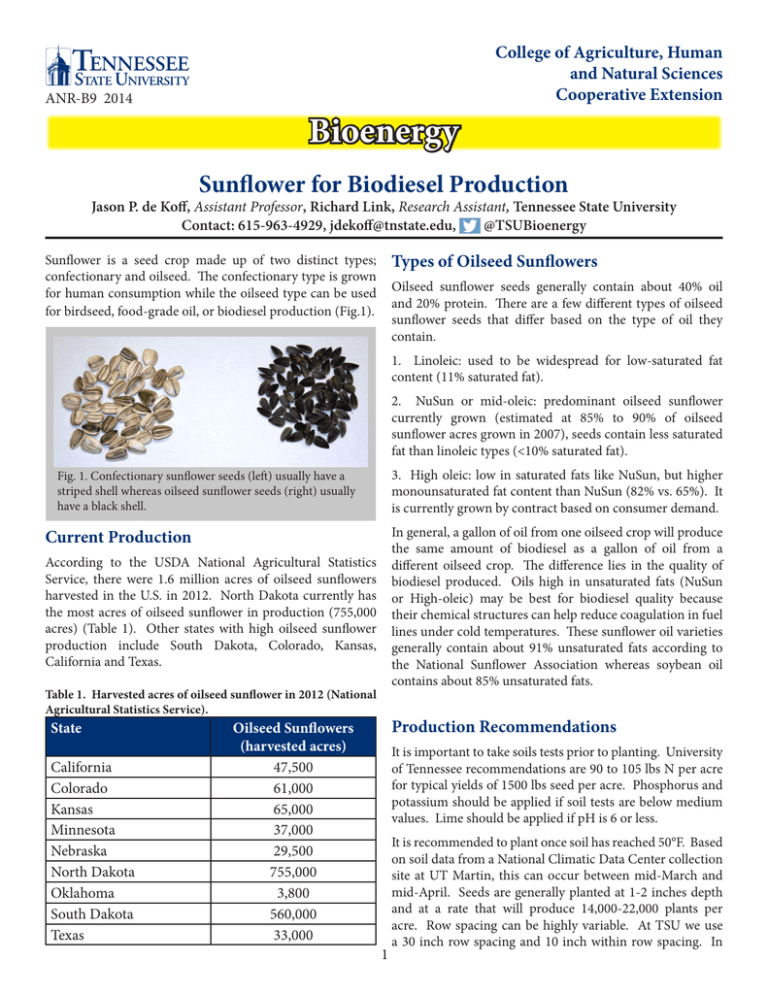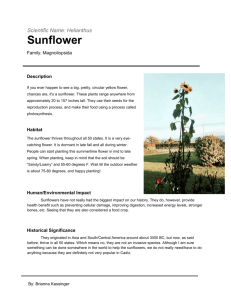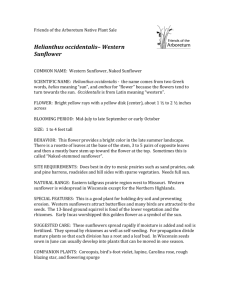Sunflower for Biodiesel Production
advertisement

ANR-B9 2014 Bioenergy College of Agriculture, Human and Natural Sciences Cooperative Extension Sunflower for Biodiesel Production Jason P. de Koff, Assistant Professor, Richard Link, Research Assistant, Tennessee State University Contact: 615-963-4929, jdekoff@tnstate.edu, @TSUBioenergy Types of Oilseed Sunflowers Sunflower is a seed crop made up of two distinct types; confectionary and oilseed. The confectionary type is grown for human consumption while the oilseed type can be used for birdseed, food-grade oil, or biodiesel production (Fig.1). Oilseed sunflower seeds generally contain about 40% oil and 20% protein. There are a few different types of oilseed sunflower seeds that differ based on the type of oil they contain. 1. Linoleic: used to be widespread for low-saturated fat content (11% saturated fat). 2. NuSun or mid-oleic: predominant oilseed sunflower currently grown (estimated at 85% to 90% of oilseed sunflower acres grown in 2007), seeds contain less saturated fat than linoleic types (<10% saturated fat). 3. High oleic: low in saturated fats like NuSun, but higher monounsaturated fat content than NuSun (82% vs. 65%). It is currently grown by contract based on consumer demand. Fig. 1. Confectionary sunflower seeds (left) usually have a striped shell whereas oilseed sunflower seeds (right) usually have a black shell. In general, a gallon of oil from one oilseed crop will produce the same amount of biodiesel as a gallon of oil from a different oilseed crop. The difference lies in the quality of biodiesel produced. Oils high in unsaturated fats (NuSun or High-oleic) may be best for biodiesel quality because their chemical structures can help reduce coagulation in fuel lines under cold temperatures. These sunflower oil varieties generally contain about 91% unsaturated fats according to the National Sunflower Association whereas soybean oil contains about 85% unsaturated fats. Current Production According to the USDA National Agricultural Statistics Service, there were 1.6 million acres of oilseed sunflowers harvested in the U.S. in 2012. North Dakota currently has the most acres of oilseed sunflower in production (755,000 acres) (Table 1). Other states with high oilseed sunflower production include South Dakota, Colorado, Kansas, California and Texas. Table 1. Harvested acres of oilseed sunflower in 2012 (National Agricultural Statistics Service). State California Colorado Kansas Minnesota Nebraska North Dakota Oklahoma South Dakota Texas Oilseed Sunflowers (harvested acres) 47,500 61,000 65,000 37,000 29,500 755,000 3,800 560,000 33,000 Production Recommendations It is important to take soils tests prior to planting. University of Tennessee recommendations are 90 to 105 lbs N per acre for typical yields of 1500 lbs seed per acre. Phosphorus and potassium should be applied if soil tests are below medium values. Lime should be applied if pH is 6 or less. 1 It is recommended to plant once soil has reached 50°F. Based on soil data from a National Climatic Data Center collection site at UT Martin, this can occur between mid-March and mid-April. Seeds are generally planted at 1-2 inches depth and at a rate that will produce 14,000-22,000 plants per acre. Row spacing can be highly variable. At TSU we use a 30 inch row spacing and 10 inch within row spacing. In early development, the heads track the sun so sunflowers are planted in N to S rows so that the plants will lean into the 30 inch row spaces rather than into each other which could cause seed loss. Preplant or preemergent herbicides are recommended for weed management as there are no herbicides registered for control of broadleaf weeds in sunflower (one exception is Clearfield® sunflowers which are resistant to imazamox which can be used to control these broadleaf weeds). Grass-type weeds can be managed once sunflowers have germinated using herbicides containing clethodim or sethoxydim. Broadleaf weeds can only be managed using tillage between rows up to the 4-6 leaf stage. Fig. 3. Sunflowers in the beginning stages of senescence at Tennessee State University AREC in Nashville. Other pest problems may include fungi and insects. Sunflowers are drought tolerant but wet periods may cause fungal issues. There are hybrids available with resistance to certain fungi but crop rotation can also help avoid these problems. For insects, those that attack the seed or those that infest the vegetation during the early formation of the bud (R1-R3 growth stages) are the most important to manage using recommended integrated pest management techniques because these may reduce yields. Insects that affect the foliage prior to bud growth are usually not so extensive as to have a significant effect on yield. Seeds are mature when the back of the flower head is yellow, and when it is brown it can usually be harvested. Seed should have 18-20% moisture or less when harvesting and a conventional grain combine with a sunflower head attachment can be used. Oil Yields In a 4 year (2004-2007) field trial conducted by the University of Tennessee, average yields were 1296 lbs seed per acre. At 40% oil content this gives about 518 lbs oil per acre. In comparison, a 5 year (2009-2013) field trial of soybeans also conducted by the University of Tennessee observed an average yield of 2340 lbs seed per acre. Soybeans, however, have a much lower oil content (~20%), and give an overall value of 468 lbs oil per acre. In other words, sunflower production yields about 50 lbs more oil per acre than soybeans. Harvesting Seeds At the Tennessee State University Agricultural Research and Education Center (AREC) in Nashville, NuSun and higholeic varieties of sunflowers bloomed about 8 to 9 weeks after planting (Fig. 2) and began to mature (senesce) around 10 to 11 weeks after planting (Fig. 3). Sunflowers are usually fully mature by 15 to 17 weeks after planting. References and Resources Allen, F.L., V.R. Sykes, R.C. Williams, Jr., A.T. McClure, H. YoungKelly, P. Donald. Soybean variety performance tests in Tennessee. Available at: http://varietytrials.tennessee.edu/soybean.htm McClure, M.A., F.L. Allen, R.D. Johnson, and L.G. Heatherly. 2010. Sunflower: an alternative crop for Tennessee producers. University of Tennessee Cooperative Extension Service, SP721. Available at: https://utextension.tennessee.edu/publications/Documents/ SP721.pdf National Sunflower Association. http://www.sunflowernsa.com/ Warrick, B.E. Sunflower Production Guide. Texas A&M AgriLife Extension. Available at: http://sanangelo.tamu.edu/extension/ agronomy/agronomy-publications/sunflower-production-guide/ http://www.extension.org/pages/29605/sunflowers-for-biofuelproduction#.UriGFbmx5dg Fig. 2. Sunflowers in bloom at Tennessee State University AREC in Nashville. Dean - Dr. Chandra Reddy, Associate Dean for Extension - Dr. Latif Lighari TSU-14-0095(A)-15-17095 Tennessee State University is an AA/EEO employer and does not discriminate on the basis of race, color, national origin, sex, disability or age in its programs and activities. 2






